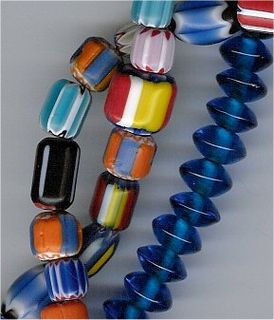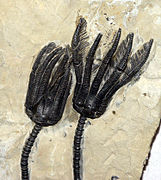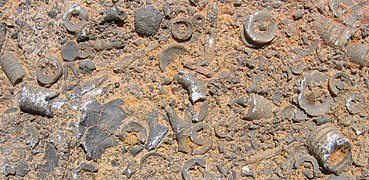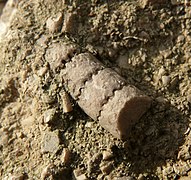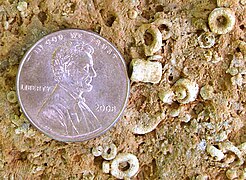
Wampum is a traditional shell bead of the Eastern Woodlands tribes of American Indians. It includes the white shell beads hand fashioned from the North Atlantic channeled whelk shell and the white and purple beads made from the quahog or Western North Atlantic hard-shelled clam.
Shell money is a medium of exchange similar to coin money and other forms of commodity money, and was once commonly used in many parts of the world. Shell money usually consisted either of whole sea shells or pieces of them, which were often worked into beads or were otherwise artificially shaped. The use of shells in trade began as direct commodity exchange, the shells having value as body ornamentation. The distinction between beads as commodities and beads as money has been the subject of debate among economic anthropologists.

The Hunsrück Slate is a Lower Devonian lithostratigraphic unit, a type of rock strata, in the German regions of the Hunsrück and Taunus. It is a lagerstätte famous for exceptional preservation of a highly diverse fossil fauna assemblage.

A Hair Pipe is a term for a elongated bead, more than 1.5 inches long, which are popular with American Indians, particularly from the Great Plains and Northwest Plateau.
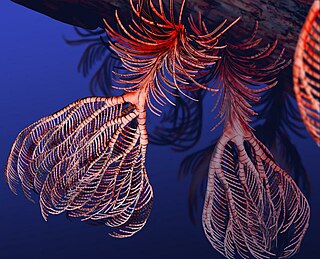
Pentacrinites is an extinct genus of crinoids that lived from the Middle Triassic to the Eocene of Asia, Europe, North America, and New Zealand. Their stems are pentagonal to star-shaped in cross-section and are the most commonly preserved parts. Pentacrinites are commonly found in the Pentacrinites Bed of the Early Jurassic of Lyme Regis, Dorset, England. Pentacrinites can be recognized by the extensions all around the stem, which are long, unbranching, and of increasing length further down, the very small cup and 5 long freely branching arms.

Paracrinoidea is an extinct class of blastozoan echinoderms. They lived in shallow seas during the Early Ordovician through the Early Silurian. While blastozoans are usually characterized by types of respiratory structures present, it is not clear what types of respiratory structures paracrinoids likely had. Despite its name, the paracrinoids are not closely related to crinoids.
Trachypora is a species of branching coral dating to the Late Devonian period 350 million years ago.
Fossils of many types of water-dwelling animals from the Devonian period are found in deposits in the U.S. state of Michigan. Among the more commonly occurring specimens are bryozoans, corals, crinoids, and brachiopods. Also found, but not so commonly, are armored fish called placoderms, snails, sharks, stromatolites, trilobites and blastoids.

Encrinus is an extinct genus of crinoids, and "one of the most famous". It lived during the Middle Triassic, and its fossils have been found in Europe.
Davidaster discoideus or the beaded crinoid is a species of feather star in the family Comasteridae. It was previously known as Nemaster discoidea but the World Register of Marine Species has determined that the valid name is Davidaster discoideus. It is found on reefs in the Caribbean Sea and northern coast of South America.

Paleontology in Ohio refers to paleontological research occurring within or conducted by people from the U.S. state of Ohio. Ohio is well known for having a great quantity and diversity of fossils preserved in its rocks. The state's fossil record begins early in the Paleozoic era, during the Cambrian period. Ohio was generally covered by seawater from that time on through the rest of the early Paleozoic. Local invertebrates included brachiopods, cephalopods, coral, graptolites, and trilobites. Vertebrates included bony fishes and sharks. The first land plants in the state grew during the Devonian. During the Carboniferous, Ohio became a more terrestrial environment with an increased diversity of plants that formed expansive swampy deltas. Amphibians and reptiles began to inhabit the state at this time, and remained present into the ensuing Permian. A gap in the local rock record spans from this point until the start of the Pleistocene. During the Ice Age, Ohio was home to giant beavers, humans, mammoths, and mastodons. Paleo-Indians collected fossils that were later incorporated into their mounds. Ohio has been the birthplace of many world famous paleontologists, like Charles Schuchert. Many significant fossils curated by museums in Europe and the United States were found in Ohio. Major local fossil discoveries include the 1965 discovery of more than 50,000 Devonian fish fossils in Cuyahoga County. The Ordovician trilobite Isotelus maximus is the Ohio state fossil.
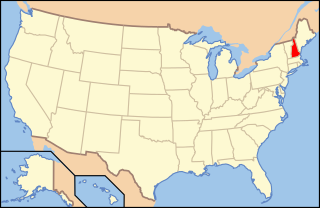
Paleontology in New Hampshire refers to paleontological research occurring within or conducted by people from the U.S. state of New Hampshire. Fossils are very rare in New Hampshire because so much of the state's geology is highly metamorphic. The state's complicated geologic history has made dating its rocks and the fossils they contain "a difficult task." The state's Devonian rocks are especially metamorphosed, yet its Mississippian rocks formed too recently to have been subject to the same metamorphism. Nevertheless, despite the geologic complications some fossils have been discovered in the state.

Paleontology in Wisconsin refers to paleontological research occurring within or conducted by people from the U.S. state of Wisconsin. Wisconsin has a relatively sparse fossil record. Fossils found in Wisconsin are generally very old, most ranging from 500 to 300 million years in age. During the early part of the Paleozoic era, Wisconsin was covered by a warm, shallow sea that would be home to creatures like brachiopods, bryozoans, cephalopods, corals, crinoids, and trilobites. During the Silurian, Wisconsin was home to massive reef system that formed one of the most biodiverse habitats in all of North America at the time. The interval spanning the Permian, Mesozoic, Paleogene and Neogene are missing from the local rock record. During the Ice Age the local climate became cold. Seals, walruses, and whales left behind fossil remains in the state near the Great Lakes. On land, hemlock and spruce trees formed forests inhabited by creatures like giant beavers, horses, and woolly mammoths. The first fossil reef systems ever scientifically documented in North America were discovered in the area around Milwaukee. The Silurian reefs of the Milwaukee area were also the first known fossil reefs from the Paleozoic era. Their associated fauna is one of the most diverse from the period ever documented in North America. The Ordovician to Silurian trilobite Calymene celebra is the Wisconsin state fossil.

Paleontology in Missouri refers to paleontological research occurring within or conducted by people from the U.S. state of Missouri. The geologic column of Missouri spans all of geologic history from the Precambrian to present with the exception of the Permian, Triassic, and Jurassic. Brachiopods are probably the most common fossils in Missouri.

Bourgueticrinida is an order of crinoids that typically live deep in the ocean. Members of this order are attached to the seabed by a slender stalk and are known as sea lilies. While other groups of crinoids flourished during the Permian, bourgueticrinids along with other extant orders did not appear until the Triassic, following a mass extinction event in which nearly all crinoids died out.
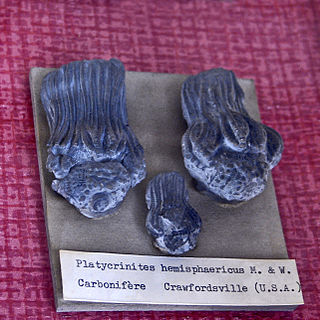
Platycrinites are an extinct genus of Paleozoic stalked crinoids belonging to the family Platycrinitidae.
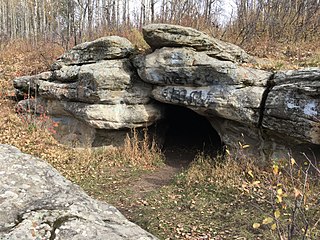
The Charlie Lake Cave (Tse'KWa) is an archaeological site in the Canadian province of British Columbia. Its Borden System designation is HbRf 39. In a waste pit in front of the small cave artifacts up to 10,500 years old have been found, which are considered to be the oldest evidence of ritual acts in Canada. The cave is located a few kilometers north of Fort St. John, near Charlie Lake.

Rock Glen Conservation Area is a suburban conservation area located in the town of Arkona, in the municipality of Lambton Shores, Ontario, Canada. The conservation is owned and maintained by the Ausable Bayfield Conservation Authority (ABCA). The former "Ausable River Conservation Authority" was Ontario's first conservation authority. It was created in 1946. The Bayfield River watershed and smaller streams were added in 1971. Local municipalities and the Province of Ontario formed "Ausable Bayfield Conservation Authority" (ABCA) to prevent the loss of important local ecosystems, to protect life and property through flood management, and to build a healthier natural environment on a watershed scale. Rock Glen Conservation Area is situated in a transition zone between the Carolinian forest zone to the south, and the Great Lakes, in Lambton Shores, Ontario, Canada. On the conservation grounds is the Arkona Lions Museum and Information Centre; which houses a collection of Devonian Era fossils and Aboriginal artifacts found in the local area.



